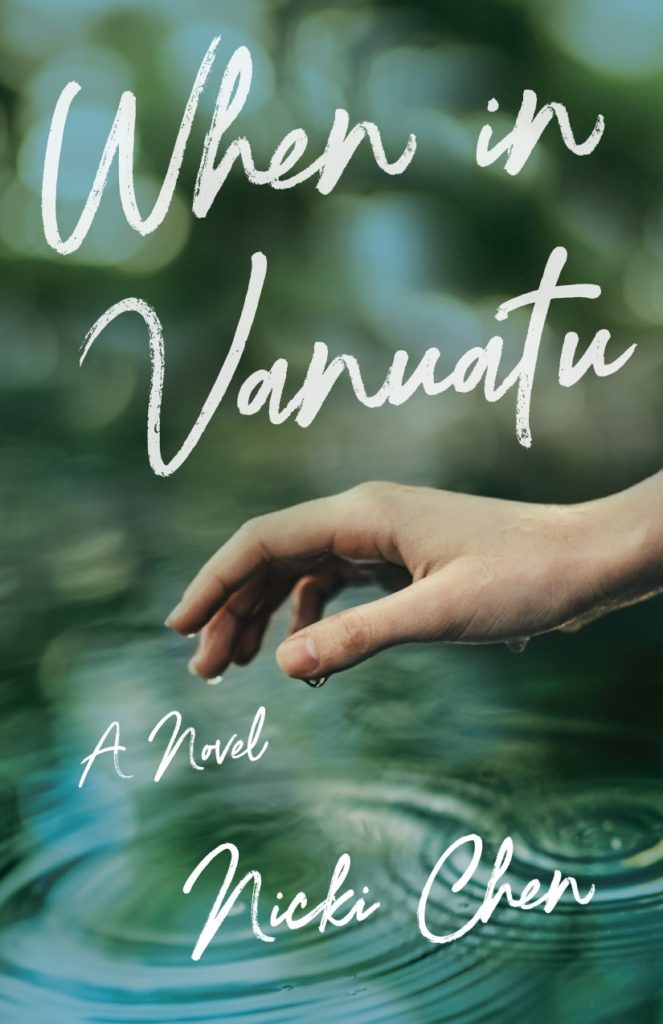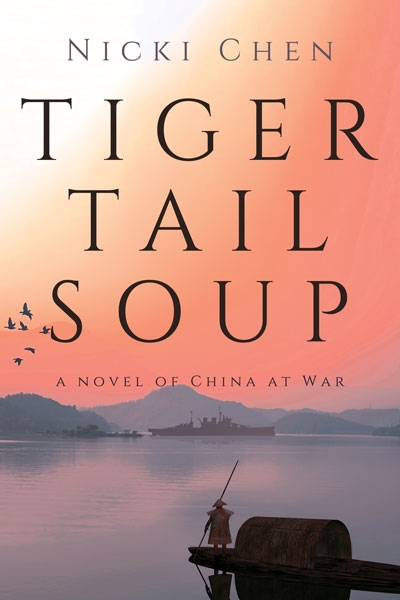 Western-style houses on a Chinese island.
Western-style houses on a Chinese island.
In 1983, my family visited my late husband’s hometown in China. We arrived by ship from Hong Kong. After a small kerfuffle about our reservations, we checked into the Hotel for Overseas Chinese in Xiamen. The next morning we boarded a ferry for the seven-minute ride to the small island-city of my husband’s birth: Gulangyu.
The son of a family friend, met us at the ferry landing, and we started toward the house Ah Pok shared with his parents and his son. As we walked through the small commercial area and up a narrow, winding lane, I was charmed by the picturesque, exotic sights of China. (It was my first trip there.) But then, suddenly, as we turned a corner, nothing looked Chinese anymore. We could have been in Italy or France.
 Over the years, my husband, Eugene, had related many stories about his childhood. But if he explained the history of Gulangyu to me, it didn’t sink in. “So” I asked, “why all these European-style houses?”
Over the years, my husband, Eugene, had related many stories about his childhood. But if he explained the history of Gulangyu to me, it didn’t sink in. “So” I asked, “why all these European-style houses?”
He shrugged. “It used to be an International Settlement.”
 Ah Pok pointed to a building with green shutters and white Colonial-style pillars and said something in the Hokkien dialect. “The American Consulate,” Eugene translated. “Now it’s the Ocean Research Center.”
Ah Pok pointed to a building with green shutters and white Colonial-style pillars and said something in the Hokkien dialect. “The American Consulate,” Eugene translated. “Now it’s the Ocean Research Center.”
 Later we passed a building that used to be Trinity Church.
Later we passed a building that used to be Trinity Church.
As it turned out, there was more to Gulangyu’s history than we could discuss on a short walk across the island. For centuries Gulangyu and nearby Xiamen (earlier known as Kulangsu and Amoy) had been centers of shipping, sometimes piracy. The same sailing ships that weighed anchor in Papeete, Apia, Manila, Acapulco and Liverpool, used to moor in Amoy and Kulangsu. During the nineteenth century, Amoy was China’s main port for exporting tea.
At about the same time, British merchants began trafficking in opium, large quantities of the drug that they shipped into China from India through the East India Company. The trade allowed them to make a profit on their Indian colony. When the Chinese emperor attempted to stop the trade and confiscate the opium, the British government sent a military force from India. They cared not only for profit, they argued, but for Britain’s “reputation, its honor, and its commitment to global free trade.”
The first Opium War, 1839-42
The Opium War consisted of a series of skirmishes and battles over a period of almost three years. When it was over, the British victors dictated the terms of the treaty, giving themselves permission to once again sell opium. In the Treaty of Nanking, the first of the so-called unequal treaties, the British also took control of Hong Kong and gained access to several “treaty ports”: Shanghai, Canton (Guangzhou), Fuzhou, Ningbo, and Amoy.
As a treaty port, Amoy attracted British, French, Japanese and American merchants, missionaries and diplomats. Most of them eventually decided to build their homes on the scenic little island of Kulangsu, a short boat ride from Amoy. They must have liked the beaches and fresh air, or perhaps it was the sense of being set apart that attracted them. Before long other foreigners settled there too. Soon there were thirteen consulates on Kulangsu. In 1903 it was officially recognized as an “International Settlement.”
Japanese invasion and occupation of Amoy, 1938-1945
The Japanese invasion of China began in July, 1937. Within months, they had conquered Beijing, Tianjin, Shanghai, and Nanjing. On May 10, 1938, they invaded Amoy. Japan wasn’t at war with the Western Powers yet, so they steered clear of the International Settlement on Kulangsu. When my husband was born later that year, Kulangsu was surrounded by occupied territory but wasn’t yet occupied.
Then, on December 7, 1941, soon after his third birthday, the Japanese bombed Pearl Harbor and simultaneously took control of Kulangsu. For the next four years, he and his family lived under occupation.
And that brings us up to 1945, which, I suppose, is enough history for one day.






Kulangyu Island is now a popular tourist destination, crowded during public holidays. But it’s still beautiful, or even more beautiful than it was back in 1983…
I’ve seen photos, and I agree, Wallace. It does look more beautiful. It doesn’t seem to have changed very much, but Xiamen is a different story. It’s unrecognizable!
Can I ask something? Was Kulangsu Amoy had an emperor or princess or royalty before?
No. I don’t think Kulangsu Amoy ever had an emperor, princess, or royalty. In my novel, when the main character was a child, she called her mother-in-law the “Mongolian princess.” But my novel is fiction, and even in the novel, she learned that the “Mongolian princess” was actually the daughter of a general.
The prince of Japan visited during the Japan Occupied period.
Thank you, Junmin. I didn’t know that. It’s another interesting fact from the history of the island.
I hope you’ll be able to find some photos of the Dutch style houses in your town. I’d love to see them and hear some of the history of that time. Did the Dutch settle all over Indonesia or only in certain areas?
I love this post, Nicki!
😀
It reminds me a lot of our little town. It used to be filled with Dutch style houses. Most of them are torn down and rebuilt now. In the past, people often compare our street with Georgetown heritage district in Penang Island, Malaysia.
I wish I could find old photos so that I can write a post about our little town. I’ll be asking around. Meanwhile, I’ll practice my writing so that when my material is enough, I can write a decent post about it. L-O-L!
In the early 80s that was quite an extraordinary trip that you made. History and its loads of invasions, colonism and wars has managed to leave fascinating landmarks for future generations. Being from Europe, I always feel bad when I see how aggressively Europeans pursued their exploration of our planet. Thank you for sharing another slice of Chinese history.
On a later trip to China (1986) my head swam trying to make sense of all the sights. The place we toured in the afternoon might be 100 years or 500, 1000, or 2000 years older than the one we saw that morning. It was hard to keep track of it all. China is such a big country with such a long history. I’m glad I could share this little slice of it.
Wonderful pictures, I wish I could have visited China at least during the earlier 90’s but well (1983 I was not even born yet!).
These European style buildings remind me a bit also of Qingdao where some of the old German colonization structures are left such as the church etc. Though I think that the colonization period is terrible all over the world, I am happy for one thing the Germans did, they found the Tsingtao brewery, Prost!
That certainly is a famous beer.
Interesting history lesson Nicki! I enjoyed this!
Thank you for the photos and illustrations. They adds so much to understanding your posts. You have a rich history. Thank you for sharing!
Thanks for your support, Paddy and Maureen.
I didn’t realize that the island you talked about in a previous post is so close to Taiwan. What area of Taiwan did your husband’s family move to?
There are actually several buildings in Taiwan as well that have a European feel and are preserved. The architecture is a popular backdrop for the famous ‘before wedding’ photo shoots.
Yes, the island is very close to Taiwan. One day while we were waiting for my husband’s cousin to get permission to take his mother’s ashes, I walked down to the waterfront to take a photo of a picturesque pine tree and almost got shot by a Chinese soldier. I guess my camera was pointing toward the Matsu Islands (politically and militarily sensitive areas). My husband came running. He told the soldier I was a foreigner who didn’t know any better and warned me to quickly put my camera away.
My husband’s family moved to Taipei.
History overflows with interesting stories. Thanks for sharing a few today.
These photos are hauntingly beautiful! You really do a wonderful job describing Gulangyu in Tiger Tail Soup!
Thank you, Susan. It’s too bad we didn’t have sunny weather while we were there, but I did get a few good pictures. And thank you so much for your interest in Tiger Tail Soup. I can’t wait to read your memoir, Good Chinese Wife.
I hope there is more coming…
I don’t know, Kate. I don’t know as much about the period after 1945. The civil war between the Communists and the Nationalists is complicated and probably a touchy subject for both sides. My husband’s family escaped to Taiwan in 1949. Later my father-in-law’s work took them to Japan, Manila and Singapore.
But in a general sense, yes, definitely more is coming–more posts and also my novel, Tiger Tail Soup.
Wow, visiting Gulangyu…in 1983! What a fascinating time to have been in China! And a fascinating place to boot!
It was kind of early to go to out-of-the-way places like Gulangyu and Xiamen. They didn’t know what to do with us, as I mentioned in an early post, “No Room at the Inn.” I’m glad our kids were old enough to appreciate and remember the trip.
Welcome to Xiamen next time and look forward to your visit again with your family and children.
Thank you, Kwon. It was a special trip, especially since Gulangyu still looked like the beautiful little island where my husband spent his childhood.